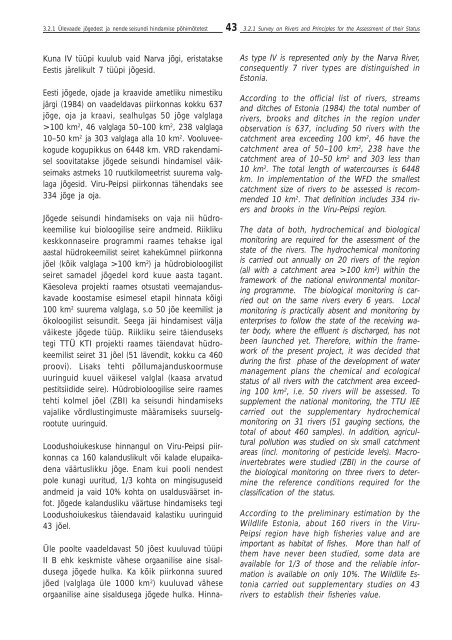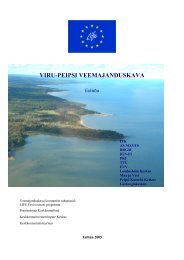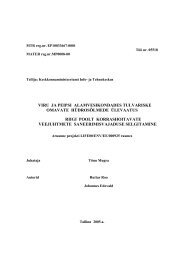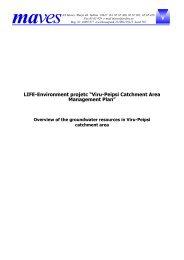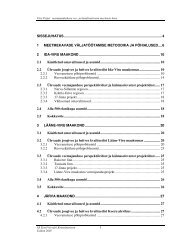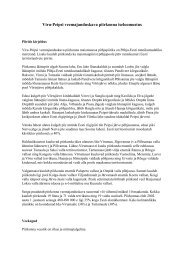Viru-Peipsi veemajanduskava - Keskkonnaministeerium
Viru-Peipsi veemajanduskava - Keskkonnaministeerium
Viru-Peipsi veemajanduskava - Keskkonnaministeerium
Create successful ePaper yourself
Turn your PDF publications into a flip-book with our unique Google optimized e-Paper software.
3.2.1 Ülevaade jõgedest ja nende seisundi hindamise põhimõtetest<br />
43<br />
3.2.1 Survey on Rivers and Principles for the Assessment of their Status<br />
Kuna IV tüüpi kuulub vaid Narva jõgi, eristatakse<br />
Eestis järelikult 7 tüüpi jõgesid.<br />
Eesti jõgede, ojade ja kraavide ametliku nimestiku<br />
järgi (1984) on vaadeldavas piirkonnas kokku 637<br />
jõge, oja ja kraavi, sealhulgas 50 jõge valglaga<br />
>100 km 2 , 46 valglaga 50–100 km 2 , 238 valglaga<br />
10–50 km 2 ja 303 valglaga alla 10 km 2 . Vooluveekogude<br />
kogupikkus on 6448 km. VRD rakendamisel<br />
soovitatakse jõgede seisundi hindamisel väikseimaks<br />
astmeks 10 ruutkilomeetrist suurema valglaga<br />
jõgesid. <strong>Viru</strong>-<strong>Peipsi</strong> piirkonnas tähendaks see<br />
334 jõge ja oja.<br />
Jõgede seisundi hindamiseks on vaja nii hüdrokeemilise<br />
kui bioloogilise seire andmeid. Riikliku<br />
keskkonnaseire programmi raames tehakse igal<br />
aastal hüdrokeemilist seiret kahekümnel piirkonna<br />
jõel (kõik valglaga >100 km 2 ) ja hüdrobioloogilist<br />
seiret samadel jõgedel kord kuue aasta tagant.<br />
Käesoleva projekti raames otsustati <strong>veemajanduskava</strong>de<br />
koostamise esimesel etapil hinnata kõigi<br />
100 km 2 suurema valglaga, s.o 50 jõe keemilist ja<br />
ökoloogilist seisundit. Seega jäi hindamisest välja<br />
väikeste jõgede tüüp. Riikliku seire täienduseks<br />
tegi TTÜ KTI projekti raames täiendavat hüdrokeemilist<br />
seiret 31 jõel (51 lävendit, kokku ca 460<br />
proovi). Lisaks tehti põllumajanduskoormuse<br />
uuringuid kuuel väikesel valglal (kaasa arvatud<br />
pestitsiidide seire). Hüdrobioloogilise seire raames<br />
tehti kolmel jõel (ZBI) ka seisundi hindamiseks<br />
vajalike võrdlustingimuste määramiseks suurselgrootute<br />
uuringuid.<br />
Loodushoiukeskuse hinnangul on <strong>Viru</strong>-<strong>Peipsi</strong> piirkonnas<br />
ca 160 kalanduslikult või kalade elupaikadena<br />
väärtuslikku jõge. Enam kui pooli nendest<br />
pole kunagi uuritud, 1/3 kohta on mingisuguseid<br />
andmeid ja vaid 10% kohta on usaldusväärset infot.<br />
Jõgede kalandusliku väärtuse hindamiseks tegi<br />
Loodushoiukeskus täiendavaid kalastiku uuringuid<br />
43 jõel.<br />
Üle poolte vaadeldavast 50 jõest kuuluvad tüüpi<br />
II B ehk keskmiste vähese orgaanilise aine sisaldusega<br />
jõgede hulka. Ka kõik piirkonna suured<br />
jõed (valglaga üle 1000 km 2 ) kuuluvad vähese<br />
orgaanilise aine sisaldusega jõgede hulka. Hinna-<br />
As type IV is represented only by the Narva River,<br />
consequently 7 river types are distinguished in<br />
Estonia.<br />
According to the official list of rivers, streams<br />
and ditches of Estonia (1984) the total number of<br />
rivers, brooks and ditches in the region under<br />
observation is 637, including 50 rivers with the<br />
catchment area exceeding 100 km 2 , 46 have the<br />
catchment area of 50–100 km 2 , 238 have the<br />
catchment area of 10–50 km 2 and 303 less than<br />
10 km 2 . The total length of watercourses is 6448<br />
km. In implementation of the WFD the smallest<br />
catchment size of rivers to be assessed is recommended<br />
10 km 2 . That definition includes 334 rivers<br />
and brooks in the <strong>Viru</strong>-<strong>Peipsi</strong> region.<br />
The data of both, hydrochemical and biological<br />
monitoring are required for the assessment of the<br />
state of the rivers. The hydrochemical monitoring<br />
is carried out annually on 20 rivers of the region<br />
(all with a catchment area >100 km 2 ) within the<br />
framework of the national environmental monitoring<br />
programme. The biological monitoring is carried<br />
out on the same rivers every 6 years. Local<br />
monitoring is practically absent and monitoring by<br />
enterprises to follow the state of the receiving water<br />
body, where the effluent is discharged, has not<br />
been launched yet. Therefore, within the framework<br />
of the present project, it was decided that<br />
during the first phase of the development of water<br />
management plans the chemical and ecological<br />
status of all rivers with the catchment area exceeding<br />
100 km 2 , i.e. 50 rivers will be assessed. To<br />
supplement the national monitoring, the TTU IEE<br />
carried out the supplementary hydrochemical<br />
monitoring on 31 rivers (51 gauging sections, the<br />
total of about 460 samples). In addition, agricultural<br />
pollution was studied on six small catchment<br />
areas (incl. monitoring of pesticide levels). Macroinvertebrates<br />
were studied (ZBI) in the course of<br />
the biological monitoring on three rivers to determine<br />
the reference conditions required for the<br />
classification of the status.<br />
According to the preliminary estimation by the<br />
Wildlife Estonia, about 160 rivers in the <strong>Viru</strong>-<br />
<strong>Peipsi</strong> region have high fisheries value and are<br />
important as habitat of fishes. More than half of<br />
them have never been studied, some data are<br />
available for 1/3 of those and the reliable information<br />
is available on only 10%. The Wildlife Estonia<br />
carried out supplementary studies on 43<br />
rivers to establish their fisheries value.


